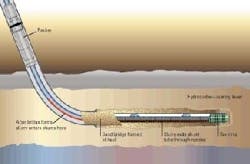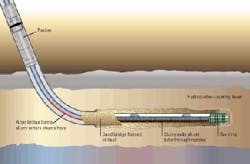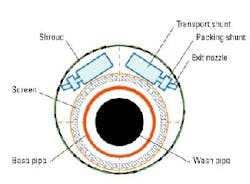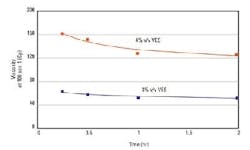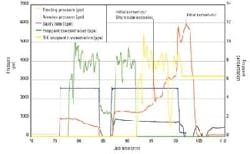COMPLETION TECHNOLOGY: Simultaneous gravel pack/clean-up use growing for horizontal wells
Industry's ability to gravel pack long horizontal well intervals and remove the filter cake at the same time has progressed substantially over the last one and one-half years. This simultaneous technique is optimized by using a specialized carrier/ breaker solution in conjunction with shunt-style, openhole gravel packs.
Results of such operations in wells in the Java Sea and Gulf of Mexico demonstrate that this combined technique can be conducted without compromising either process as it reduces completion costs and improves well productivity.
To date, stand-alone screens have been the predominant method used to control sands in horizontal open-hole wells. However, due to some notable limitations with this approach (plugged or eroded screens that impact well productivity, for example), engineers are increasingly choosing gravel pack completions for this type of well, particularly in costly deepwater environments, and when high production rates or subsea completions are present.
Given these conditions, intervention risks and costs can be prohibitive. Current estimates are that by 2003-2004 about 60% of wells fitting this description will be completed with gravel packs.
With gravel pack completions, the goal is improved with sand control over the life of a well and thus improved long-term deliverability and reserves recovery. However, while gravel packs stabilize the wellbore, they also can entrap the filter cake that forms on the wellbore wall during drilling. This can result in high drawdown pressures and/or low production rates due to reduced retained permeabilities.
Thus, thoroughly removing the filter cake over the length of the gravel pack has been a focus in recent years. Experience has shown that filter cake cleanup in gravel-packed open-hole horizontal completions is a necessity, except when the productive reservoir has permeabilities over several darcies and very clean coarse sand particles that can be contained with large-sized gravel. In the latter case, fines migration and other drawdown-limiting factors are not of concern.
Filter cake cleanup practices have traditionally involved multiple steps, including the use of aggressive chemicals, such as hydrochloric acid (HCl) applied by running coiled tubing down the hole after packing. More recently, several new techniques have been developed, including:
- Use of a modified service tool that allows circulation of cleanup chemicals into the base pipe immediately after gravel packing, which eliminates coiled tubing
- Simultaneous gravel packing and cake cleanup, which completely eliminates the need to remove the remaining filter cake after packing
- Novel chemical systems (fluids) that improve cleanup efficiency and reduce screen corrosion.
Technology components
The case study that follows, which demonstrates the advantages of simultaneously gravel packing and cleaning up a horizontal well section, takes advantage of several leading-edge technologies.
- Shunt-style, shrouded gravel pack screen
- Single carrier/breaker fluid that carries the gravel into the annulus and breaks the filter cake.
The shunt-style gravel pack screens, key to the Alternate Path Technologytrademark (APT) approach, ensure thorough gravel and fluid placement in the screen/openhole annulus. Studies have shown that APT gravel packing configurations are independent of formation and cake properties. As well, they do not require high fluid velocities for gravel transport. Instead, the APT approach uses shunt tubes attached to the screen to provide alternative conduits for slurry to flow past any bridges that may form in the annulus outside the screen. Comprehensive, heel-to-toe gravel pack coverage is ensured.
The APT approach has been adapted to long horizontal, open-hole intervals by adjusting shunt exit port design to eliminate internal slurry concentration. Specifically, low-damaging fluids with good gravel carrying capacity are applied at low shear rates. A perforated shroud is used to protect and centralize the screen in the horizontal hole. Site-specific design and operating parameters are established using wellbore simulation.
Use of the APT method eliminates several issues often associated with the traditional high-rate water packing technique, such as the need to pump lost circulation pills to establish well circulation prior to gravel packing. Further, because complete packing is always achieved, premium screens are not required as a backup for controlling the formation sand.
The APT approach also minimizes the problems associated with reactive shales. In the presence of shale zones, flow can be diverted to shunts to avoid fluid and gravel pack contamination. This is achieved by pumping the gravel pack in circulating position with the wash pipe unstung from the shoe. As soon as the slurry is exposed to the screen, it dehydrates against it, forming a bridge.
Then the fluid is diverted to the shunt tubes, and the gravel pack progresses from heel to toe, only traveling the distance between nozzles (3 ft) in the open hole. This minimizes contamination from sloughing formations.
The complementary part of the simultaneous pack and clean technique are single-stage cleanup fluids, or MudSOLV* breakers, carried in a base of ClearFRAC viscoelastic surfactant (VES), which is polymer-free and solids-free. When the breaking chemicals can be combined with a carrier fluid, an otherwise two- or three-step process (gravel pack, enzyme soak, acid treatment) is reduced to a single step.
Being solids free, the VES carrier fluids do not impair gravel pack and formation permeability, as occurs with polymer-based fluids. They also break via contact with produced liquid hydrocarbons or dilution by produced brine. There is only one caution with the VES approach: some crudes react with VES fluids to form emulsions, so compatibility testing is an important part of the design process.
Given the characteristics of the VES carrier fluid, filter-cake-breaking chemicals can be included with it, provided that they do not react with one another or create corrosive conditions downhole. This allows them to "soak" or work on removing the filter cake for longer periods of time than when applied post-pack, eliminating concern about the variability of cleanup time required at different points along the filter cake face. The cake can be removed at any time prior to the well being put on production.
Chemical breaking agents used to dissolve the typical drilling fluid and resulting cake components include a combination of alpha amylase enzyme (AAE) and a chelating agent solution (CAS), used respectively to dissolve the starch and calcium carbonate (CaCO3 ) components. Fortunately, the pH of CAS is inherently compatible with AAE, which generates the right pH environment needed for the enzyme to be effective without adding buffers or diluting the fluid. This permits its simultaneous use in single-stage treatments and maximum CaCO3 dissolving power.
CAS has an order of magnitude slower reaction rate when compared to acid, resulting in fluid retardation and uniform cake dissolution without creating pinholes in the filter cake. CAS' lower corrosion rate also prevents completion goods damage, especially when long soak times are anticipated. Typically 24-48 hours will elapse after the gravel pack is placed, until the final completion is run and the well is put on production.
Extensive lab testing is used when designing a site-specific carrier/breaker fluid to obtain the right fluid rheology, dissolving power and compatibility with formation oil.
US Gulf application
Looking for a cost-effective, technically sound way to drill and complete a short horizontal sidetrack while avoiding a nearby water contact, an integrated package that included directional drilling with downhole data acquisition, reservoir modeling, fluids and completion services was chosen. This integrated package would include the first-ever attempt to simultaneously gravel pack and remove the filter cake from a horizontal wellbore in the Gulf of Mexico.
The sidetrack was kicked off in mid-2000 from an existing wellbore in the Gulf of Mexico. Ultimately a 277-ft horizontal wellbore was drilled and successfully completed in the ±15-ft FK sand interval in less than 48 hr.
Avoiding the water contact, minimizing formation damage, and maximizing reservoir exposure were the prime objectives. Geosteering techniques (measurement and logging while drilling) were used, and results (phase/shift for sand and attenuation for shale) were conveyed in real-time mode to the operator's office for optimal wellbore placement decisions.
With sand control being an issue, the company chose to simultaneously gravel pack and clean the horizontal section. Objectives of the completion phase itself included:
- Completely packing the 277-ft openhole interval with 40/60 gravel
- Uniformly cleaning the filter cake without use of a post-pack treatment
- Producing hydrocarbons free of formation sand or water.
The viscous carrier/breaker system chosen had a formulation of 3% VES carrier and 4% KCl (potasium chloride), 50% CAS, 2% enzyme, and 0.1% corrosion inhibitor. Lab studies ensured that this formulation would not only serve to pack and clean the well as desired, but also was compatible with the chosen drilling fluid.
The carrier/breaker solution was combined with the shrouded-screen, shunt-style APT packing hardware. A 5.52-in. OD shrouded screen slightly longer than 271 ft was placed in the 277-ft, 6 3/4-in. horizontal open hole. The pressure profile observed while packing the well showed clear indications that a gravel bridge had formed, and the shunt tubes were activated at around 96 minutes. All of the gravel pumped after that was placed through the shunt tubes.
Once put on flow, the well produced 100% higher than expected, or 15 MMcf/d, without water and with near-zero skin. Absolutely no additional stimulation measures were required after packing and cleaning the horizontal section. Cumulative production in 20 weeks was 1.7 Bcf. Bottom line, payout was reached on this well 55 days after the drilling/completion sequence was finalized. Use of the simultaneous gravel pack/cleanup technique was so successful that the company plans on using it in future sand control wells in the Gulf.
Outlook
Growing field applications of the simultaneous gravel pack/cleanup technique are showing that there are technical as well as economic advantages to this sand control completion approach in horizontal wells, particularly those found in high-cost markets like the offshore. In most cases to date, the added costs of the leading-edge fluids and hardware technologies required are more than offset by eliminating the costs and associated risks of other procedures (post-pack cleanup procedures) coupled with the improved short- and long-term well productivity that results.
Acknowledgment
Schlumberger granted permission to publish this article. Many team members provided expertise on the case study cited.
